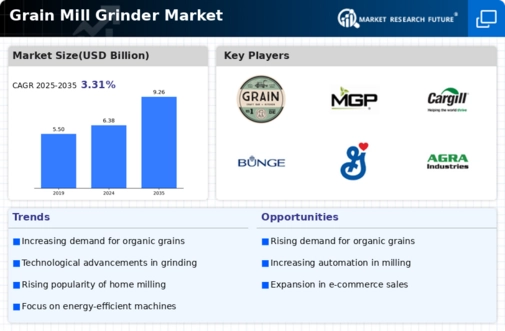Growth of Home Milling Trends
The trend of home milling is gaining traction, significantly impacting the Grain Mill Grinder Market. As consumers become more interested in homemade products and artisanal cooking, the demand for home grain mill grinders is on the rise. Market Research Future indicates that sales of home milling equipment have increased by approximately 20% in recent years, driven by a desire for fresh, unprocessed ingredients. This shift is further fueled by the growing awareness of the nutritional benefits associated with freshly milled grains. Consequently, manufacturers are responding by developing compact, user-friendly grain mill grinders that cater to home users. This trend not only reflects changing consumer preferences but also highlights the potential for growth within the Grain Mill Grinder Market.
Increased Focus on Food Security
The emphasis on food security is becoming increasingly relevant, serving as a significant driver in the Grain Mill Grinder Market. As populations grow and agricultural challenges arise, the need for efficient grain processing solutions is paramount. Governments and organizations are investing in technologies that enhance food production and processing capabilities. Market data indicates that investments in agricultural technology, including grain milling solutions, are projected to rise by 12% annually. This focus on food security not only drives demand for grain mill grinders but also encourages innovation in the industry. Manufacturers are thus motivated to develop more efficient and sustainable grinding solutions that can contribute to global food security efforts, making this a critical driver in the Grain Mill Grinder Market.
Rising Demand for Organic Products
The increasing consumer preference for organic and natural food products is a notable driver in the Grain Mill Grinder Market. As more individuals become health-conscious, the demand for organic grains has surged. This trend is reflected in market data, indicating that organic grain sales have seen a compound annual growth rate of approximately 10% over the past few years. Consequently, grain mill grinders that can efficiently process organic grains are becoming essential for both commercial and home use. This shift towards organic consumption not only influences purchasing decisions but also encourages manufacturers to innovate and enhance their product offerings. The Grain Mill Grinder Market is thus witnessing a transformation, as companies strive to meet the evolving needs of health-oriented consumers.
Sustainability and Eco-Friendly Practices
Sustainability is increasingly influencing consumer choices, acting as a vital driver in the Grain Mill Grinder Market. As awareness of environmental issues grows, consumers are seeking products that align with eco-friendly practices. This trend is reflected in the rising demand for energy-efficient grain mill grinders that minimize waste and reduce carbon footprints. Market data suggests that the eco-friendly appliance segment is expected to grow by 18% over the next five years. Manufacturers are responding by incorporating sustainable materials and energy-efficient technologies into their designs. This shift not only meets consumer expectations but also positions companies favorably in a competitive market. The commitment to sustainability is thus reshaping the Grain Mill Grinder Market, driving innovation and attracting environmentally conscious consumers.
Technological Innovations in Grinding Equipment
Technological advancements play a crucial role in shaping the Grain Mill Grinder Market. Innovations such as improved grinding mechanisms, energy-efficient motors, and smart technology integration are enhancing the performance and efficiency of grain mill grinders. For instance, the introduction of digital controls and automation in grinding processes has led to increased precision and reduced operational costs. Market data suggests that the adoption of advanced grinding technologies is expected to grow by 15% annually, as manufacturers seek to optimize production and meet rising consumer demands. This trend not only boosts productivity but also aligns with the industry's focus on sustainability and energy conservation, making it a pivotal driver in the Grain Mill Grinder Market.


















Leave a Comment